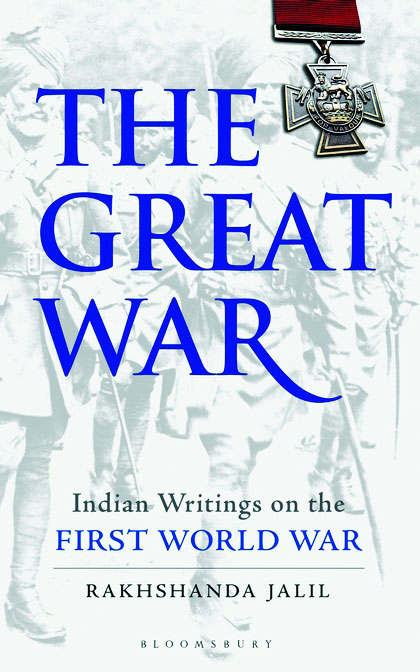The Great War: Indian Writings on the First World War
Author :Rakhshanda Jalil
Publisher : Bloomsbury, Rs 699
Rakhshanda Jalil’s The Great War is engaging and moving in equal measure. It skillfully translates rare Indian literature about the World Wars and makes a whole new world of information accessible to readers, writes Anubhav Pradhan
If you were to walk down Delhi’s Inner Ring Road from the Naraina flyover, then just by the Brar Square junction a lane goes right into the Cantonment. If you were to then brave a few forbidding barricades down this serpentine lane and half a dozen motionless sentries, you will chance upon an open lawn marked with rows upon rows of spotless clean crosses. A sombre oasis of peace, sternly neoclassical, this is the Delhi War Cemetery.
Created in 1951, the Cemetery is dedicated to the memory of over a thousand British and Indian personnel lost to World Wars I and II. It is an important node in commemorative architecture of Delhi, connected also to a global network of Commonwealth war graves. Over the past four years, the centenary years of World War I, it and hundreds of similar cemeteries have witnessed solemn memorials to that terrible catastrophe which changed the destiny of human civilisation.
But Loos, Somme, and Verdun mean little to us in India. These wars have never been ours, and even though we supplied men and resources rivalling most other combatants, we don’t really have a sense of loss associated with these calamities. The Indian attitude to the World Wars is perhaps summarily reflected in Delhi’s attitude to its only war cemetery: We know it happened, we have some vague memory of it, but we don’t really care.
Which is why it’s difficult to make much of Rakhshanda Jalil’s latest book, The Great War: Indian Writings on the First World War. As a book, as a compilation of translations, it is readable, but on the whole I seriously doubt if it will interest anyone apart from esoteric tinkerers in military history.
It’s difficult to say this, more so because personally I found the book fascinating and richly evocative. I have found myself becoming increasingly receptive to the call of history over the past few years, keenly aware of the long shadow of the past in determining our present. We in India anyway live in the womb of time: Our heads buried half in yesterday, yearning for absolutions which may never come. Reading this book on the Great War was both rousing and rewarding. It opened new lines of enquiries, and layered the evolving contours of Indian self-determination at the cusp of a strange modernity. I knew well, for instance, of Gadar di Goonj and the massive churning of revolutionary fervour from the balmy shores of California to the fertile fields of Punjab. But of Hyderabad and Awadh and Aden and Sinai I had not read before, nor was I acquainted with jangnamas and inquilabi nazms.
So, for more reasons than can be recounted here, The Great War has been informative and engaging in equal measure. Take, for instance, “She Had Said”, Jalil’s careful translation of Chandradhar Sharma Guleri’s Hindi classic “Ussne Kaha Tha”. The fine delicacy of sentiment in this story, the commitment to a higher ideal of sacrifice even in the face of pain and death has the power to thrill the heart like only masterpieces do. Similarly, Josh Malihabadi’s “Shikast-e Zindaan ka Khwaab”, translated oddly in “The Dream of a Defeated Prison”, excites the soul with its clarion call to action:
Sambhlo ki woh zindaan guunj utha, jhapto ki who qaidi chhutgae
Uttho ki woh baithin diwaren, daudo ki woh tuuti zanjiren
But even as I am moved by the book, I still doubt if other readers will find it interesting or useful. Not because it’s not striking or gripping, but simply because it’s a little too off the beaten track for a casual reader to find it worth the effort.
I also have a lurking suspicion that scholarly readers may well find it a little too complacent to be fully impressed by it. Jalil arranges her selections into prose and poetry, but such an umbrella division hardly does justice to the breadth of representative genres she seeks to cram into these categories. While she acknowledges her inability to access texts from any other Indian language except Urdu and Hindi, she has not allowed this to be reflected in the book’s branding: These are, for the most, Urdu and Hindi writings on the Great War, not ‘Indian’ by any stretch of the imagination. Likewise, some amount of archival digging has been done, but not enough to satisfy close scrutiny.
In effect, then, though the book is a welcome addition to the existing corpus of literature on the Great War and India, its public destiny seems fated to mirror the Delhi War Cemetery: A richly evocative monument, but unknown and uncared by the general eye.
The reviewer is a doctoral candidate with the Department of English, Jamia Millia Islamia. The views expressed here are his own


























